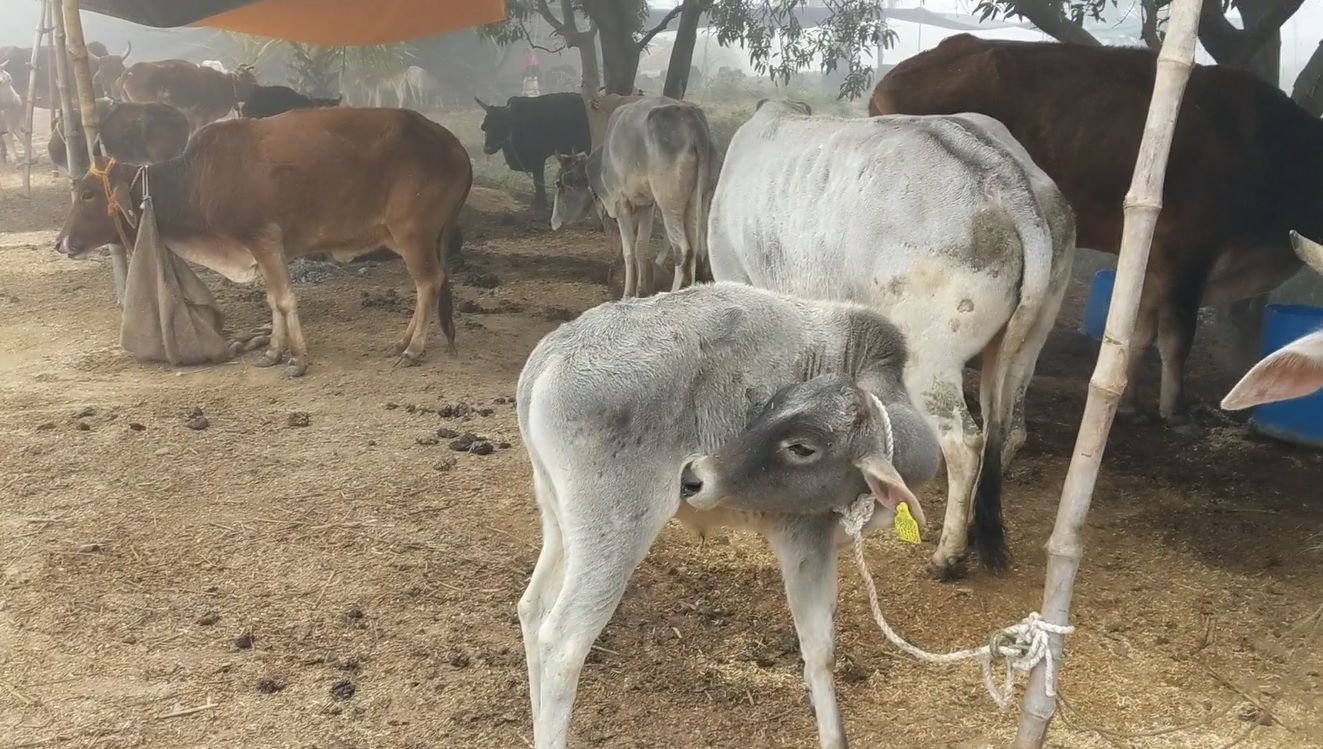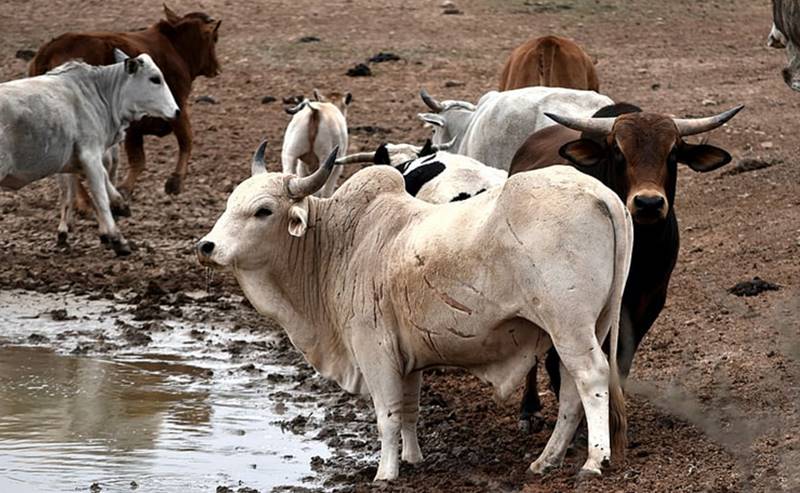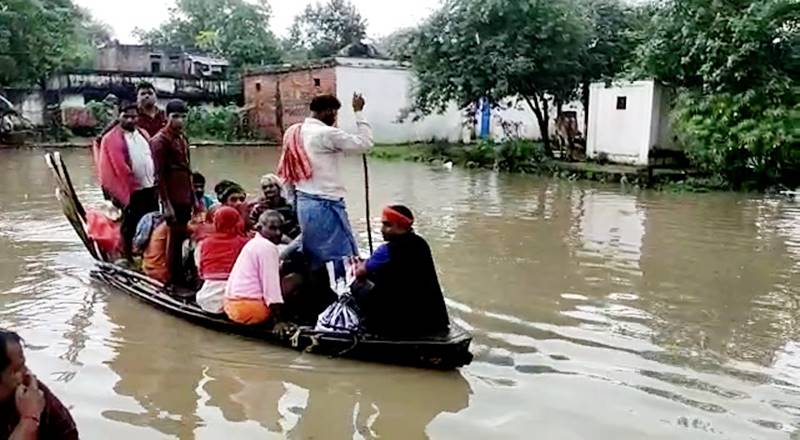Ground report: Maimed by floods, cattle in flood-hit parts of UP and MP face fodder shortage
As the floodwaters have begun to recede in the flood-hit districts of Madhya Pradesh and Uttar Pradesh, farmers are forced to abandon their cattle as they have no fodder to feed their animals. Villagers claim non-milk producing cattle are on the brink of starvation. A Gaon Connection report from flood-hit Bhind and Etawah districts.

Bhind/Etawah (Madhya Pradesh/Uttar Pradesh)
Standing on a mound, all that Gajendra Singh Rajawat could see around him was heaps of rubble and muck left behind by the floods that recently hit his Khaira Shyampura village. “There’s nothing left for even humans to eat, what can we give to our cattle?” said Rajawat, a resident of Bhind district of Madhya Pradesh.
The 43-year-old is one of the many villagers who have lost their cattle to the floods or are on the brink of losing them owing to the severe shortage of fodder for their animals.
A few metres away from Rajawat, stood horror-struck Rammurti Devi who wiped her eyes with the corner of her sari and narrated her ordeal to Gaon Connection. who “I have lost two buffaloes because of the massive floods that hit the village on the night of August 3,” the 65-year-old said.
The destruction caused by the floods in the Sindh river, a tributary of Yamuna that flows through Madhya Pradesh and Uttar Pradesh, has affected as many as 50 villages in Bhind district alone. Overall, more than 1,200 villages across Madhya Pradesh were hit by the floods, which the local villagers assert are unprecedented.

The floods have pulverised villages and inhabitants are left with almost nothing. All the stored food grains have rotted too. There is an acute shortage of fodder because of which cattle, which survived the rising waters of the river, are dying.
A dejected Rajawat told Gaon Connection that many people have untied their cattle and have let them go due to the inability of the villagers to feed their animals.
Also Read: UP floods ground report: 406 villages inundated in Mirzapur as Ganga flows above danger mark
“We people are very attached to our cattle but the flood water has rendered us helpless. There’s nothing left in the village to feed them,” said the 43-year-old villager. “The crops are ruined, the cattle feed has rotten after getting spoiled by water. Many villagers have left their beloved animals to fend for themselves,” he added.

The terrain in Bhind is uneven and people survived the floods by living in makeshift tarpaulin shelters in the higher areas. Cultivation of crops like corn, barley, and pulses is the mainstay of the people but the crops were all destroyed by the flood water that submerged the agriculture field for at least five days, complain villagers.
Cattle maimed by the floods
In the neighbouring district of Uttar Pradesh, as many as 21 districts are reeling under the destruction caused by the floods due to excessive rainfall.
About a hundred kilometres from Bhind, Etawah district in Uttar Pradesh bears a similar sight as 50 villages here have turned into a messy swamp with a pervasive rotting smell emanating from the flood-hit houses.
Villagers are reportedly facing a severe shortage of fodder while the cattle are also suffering from health conditions like infections, diarrhoea, fever, fractures and other injuries.
Gaon Connection talked to Rajaram Dohre, a para-veterinary doctor who has been working in the flood-hit villages of Etawah and treating animals who have been injured in the floods or have got infected with a disease.
“In August itself, I provided medication to as many as a hundred animals. Most of them are suffering from high fever, fractured legs, eye injuries, fever due to infectious diseases,” the veterinarian told Gaon Connection.
“Many animals have injured themselves due to being stuck in the bushes. Some have gotten sick due to drinking the dirty flood water,” he added.
Milch cattle in Uttar Pradesh and Madhya Pradesh getting affected by floods may have larger implications as along with Gujarat, Andhra Pradesh and Punjab, these two states are considered major milk producing states in India.
Cattle too face mental health issues
Rameshwar Singh, Vice Chancellor of the Bihar Animal Sciences University, Patna, told Gaon Connection that apart from physical difficulties during floods, the cattle also go through a great deal of mental duress which often affects their milk yielding capability.

“Apart from the disease and infections whose risk rises during the floods, the cattle are often traumatised due to displacement and their psychological health suffers,” the vice chancellor said. “The flood also results in a lot of decomposition and swarms of mosquitoes and flies invade the villages. Helpless and hungry, the cattle find it troublesome to cope with the irritation caused by the insects,” he added.
Overburdened veterinary infrastructure
Meanwhile, Rakesh Kumar Singh, president of the Uttar Pradesh Animal Health Union, an unofficial organisation of the veterinary doctors in the state, told Gaon Connection that the veterinary infrastructure in the state is utterly understaffed.
“According to the standard rules, a single veterinarian should not have more than 5,000 animals in his field of operation. But as of now, 35,000 animals are allotted to a single vet doctor on an average,” informed Rakesh Kumar Singh. According to him that was the reason why animal health suffered in the state. “Foot and mouth disease (FMD) vaccines were supposed to reach us before the monsoon but it hasn’t been supplied even now,” he said.
Fodder supply faltering
The Saryu river (also known as Ghaghara) is known to flood the Rampur Mathura block in Sitapur district almost every year. Tej Bahadur, a resident of the Godanha village told Gaon Connection that the fodder used to be supplied every year when it flooded but there has been no delivery this year.

“The government used to send fodder when our village used to get affected by the floods. But this year we have received none. Farmers are somehow managing to feed their milk producing cattle but the animals like bulls, old cows and calves are on the verge of starvation,” Bahadur told Gaon Connection.
On this, the Vice Chancellor of the Bihar Animal Sciences University said that in conditions like floods, it is the responsibility of the state disaster relief force (SDRF) to ensure that the flood-hit villages get their fodder supply.

